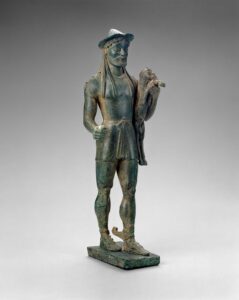[4]αὖθις δ᾽ ἰοῦσιν ἐπὶ Λεχαίου τὴν εὐθεῖαν χαλκοῦς καθήμενός ἐστιν Ἑρμῆς, παρέστηκε δέ οἱ κριός, ὅτι Ἑρμῆς μάλιστα δοκεῖ θεῶν ἐφορᾶν καὶ αὔξειν ποίμνας, καθὰ δὴ καὶ Ὅμηρος ἐν Ἰλιάδι ἐποίησεν
υἱὸν Φόρβαντος πολυμήλου, τόν ῥα μάλιστα
Ἑρμείας Τρώων ἐφίλει καὶ κτῆσιν ὄπασσε:
τὸν δὲ ἐν τελετῇ Μητρὸς ἐπὶ Ἑρμῇ λεγόμενον καὶ τῷ κριῷ λόγον ἐπιστάμενος οὐ λέγω. μετὰ δὲ τὸ ἄγαλμα τοῦ Ἑρμοῦ Ποσειδῶν καὶ Λευκοθέα καὶ ἐπὶ δελφῖνός ἐστιν ὁ Παλαίμων.
- Map
- Pre Reading
- Post Reading
- Culture Essay
Lewis R. Farnell (The Cults of the Greek States 1896, vol. I, part I, p. 9) described Hermes Kriophoros thus:
- “As Arcadia has been from time immemorial the great pasture-ground of Greece, so probably the most primitive character in which Hermes appeared, and which he never abandoned, was pastoral. He is the Lord of the herds, epimélios and kriophoros, who leads them to the sweet waters, and bears the tired ram or lamb on his shoulders, and assists them with the shepherd’s crook, the kerykeion.”
Later, the Hermes Kriophoros can be seen as the inspiration of images of Jesus the Good Shepherd in catacombs, sarcophagi, and free-standing sculpture. Why is this image so frequently depicted by different traditions? Does it have the same meaning from tradition to tradition?
Why does Pausanias say that he knows, but will not tell, the story of Hermes and the ram?
N/A
